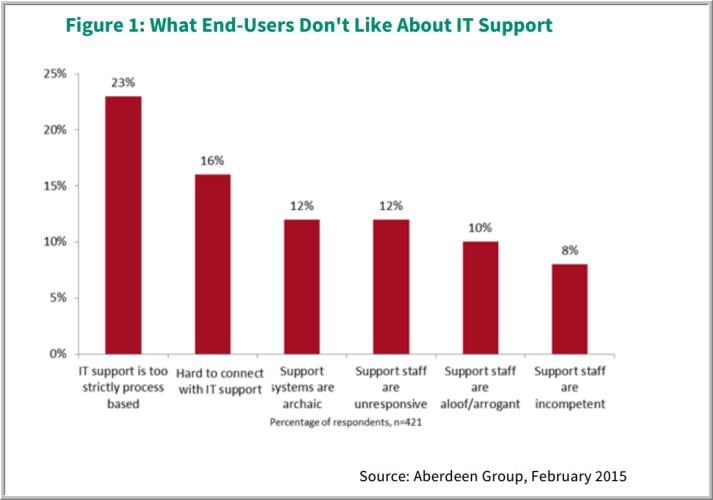If you run an ITSM operation and your users seem unhappy, you’re not alone. As I discussed last time, a recent Aberdeen Group report,Embracing 21st Century ITSM, documents research showing that 25% of users were dissatisfied, 6% extremely so, with the IT service they received.
The researchers delved into the causes of this dissatisfaction. As shown in the graph, the top complaint – from 23% of respondents – was that IT support is too strictly process based. Other problems included a feeling that it is hard to connect with IT support, that support systems are archaic, and that support staff are unresponsive. Aberdeen points out that many of these problems are clearly explained by traditional ITSM approaches.
My observation is that typically these systems are driven by a process centric approach and have lost sight of the customer experience. They rely on users filling in forms that often seem unnecessarily bureaucratic, and then give them very little back in return. Traditional tools have not evolved to embrace new customer behavior and expectations driven by experiences with consumer Apps. There is no chance to discuss your issue or collaborate in any other way – you just have to take what you’re given. They have failed to engage customers which is resulting in increasing dissatisfaction.
These systems don’t make life easy for the service desk team either. Quite probably, users’ complaints of unresponsiveness on the part of support staff are actually a reflection on the systems rather than the staff. Too often, ITSM solutions fail to shield your staff from the complexity of the ITSM lifecycle, make it difficult to find knowledge and expertise and don’t facilitate effective teamwork and communication, requiring analysts to step out of the support environment to communicate, resulting in valuable tribal knowledge staying in an ‘inbox’ and inaccessible by others. Not only is this frustrating and inefficient more worryingly it is often the limiting factor in the drive to increase customer satisfaction.
At first sight, this is rather a depressing line of thought, but from the ITSM manager’s point of view it could be seen as a positive. There is a real opportunity to revolutionize the customer experience by addressing the underlying problem and moving to a more collaborative approach with customers and collaborative working practices within the team delivering and supporting IT services.
Greater efficiency and productivity gains result in lower costs. Innovative working practices, underpinned by a familiar, modern, socially influenced service desk application jointly drive better outcomes and enhanced service desk analyst motivation. In a future post I’ll look more closely at the benefits Aberdeen found that best-in-class ITSM functions gain from using this approach.
The report looks at best practice to find out how it’s possible to do this in practical terms. That’s the aspect I’ll cover next time.
Back to Hornbill Blog

End-users – what upsets them and what makes them happy?

Hornbill ESM
Automate up to 90% of interaction and activity. Make time. Be future-ready.
Comments:
Looking for More?
No problem. Here’s some useful resources to help you on your ESM journey.


